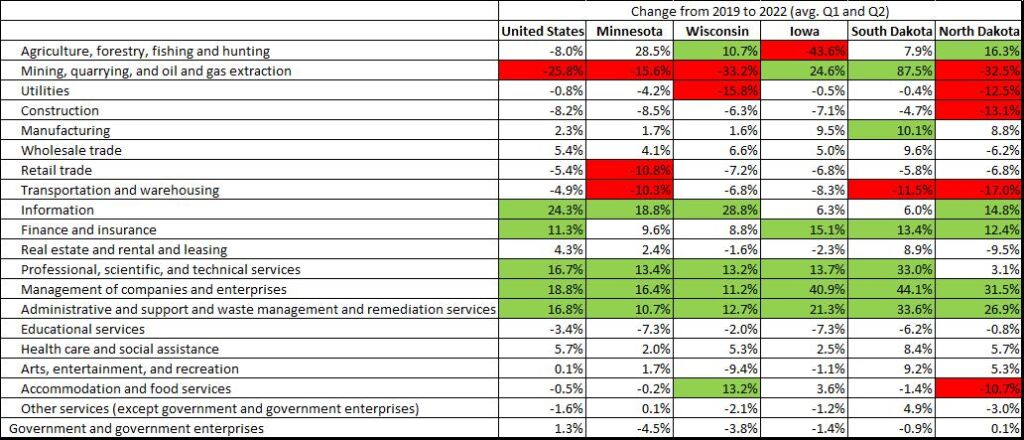The national crash in the extractive industries has hit North Dakota’s economy especially hard
While writing a recent post about how Minnesota’s economic growth is below average, I was struck by the diverging post-COVID-19 growth rates of our neighbors.
As Figure 1 shows, from the fourth quarter of 2019 (the last before the pandemic hit) to the second quarter of 2022 (the most recent for which we have data), South Dakota’s economy has grown, in real terms, by 6.0%, the eleventh best rate in the country. Some way below that come Wisconsin and Minnesota, with growth of 1.7% each, followed by Iowa, whose economy is 0.2% smaller than it was and, finally, North Dakota, whose economy was a hefty 6.4% smaller in the most recent quarter than it was before COVID-19.
Figure 2: Percentage change in real GDP, 2019:Q4 to 2022:Q2

What is behind these differences?
Let us start by looking at the economies of these states by sector in 2019. Table 1 shows the share of GDP accounted for by sectors for the United States generally, Minnesota, and its neighbors. Both Iowa and South Dakota derived large shares of GDP from the ‘Finance, insurance, real estate, rental, and leasing’ sector in 2019 (22.4% and 23.0% respectively), but only slightly more so than the United States generally (18.8%).
Table 1: Share of GDP by sector, 2019

Table 2 gives you some idea of which states are much more exposed than the United States average by showing the percentage point differences between the sectoral share for that state and for the United States generally. We see that for for the five states, sectoral GDP shares match those of the United States generally reasonably closely, with a difference -/+ of less than five percentage points. The striking exception is the ‘Mining, quarrying, and oil and gas extraction’ sector in North Dakota, which was 20.3 percentage points larger in 2019 than the it was for the United States generally.
Table 2: Percentage point difference from United States’ sectoral share of GDP, 2019

Given the disproportionate reliance of North Dakota’s economy on the ‘Mining, quarrying, and oil and gas extraction’ sector, any downturn in the sector is going to hit especially hard. As Table 3 shows, this has been the case. The downturn in the sector in North Dakota has not been as severe as in Wisconsin, down 32.5% vs 33.2%, but this sector accounted for 22.9% of North Dakota’s GDP in 2019 but just 0.3% in Wisconsin.
Table 3: Real GDP change by sector

This crash in the ‘Mining, quarrying, and oil and gas extraction’ sector has hit across the United States but has hit North Dakota’s economy especially hard. Given the country’s desperate need for energy, this is staggering and addressing it ought to be a priority of policy at every level.